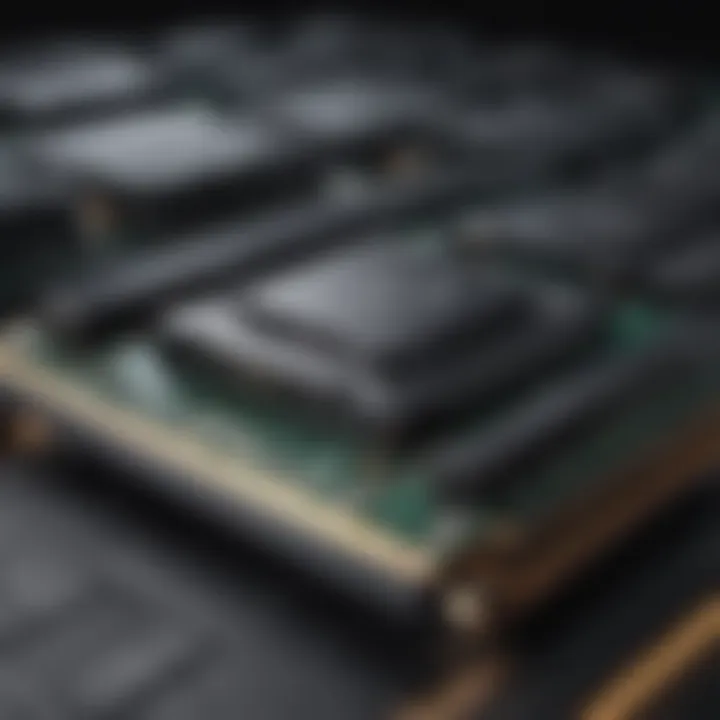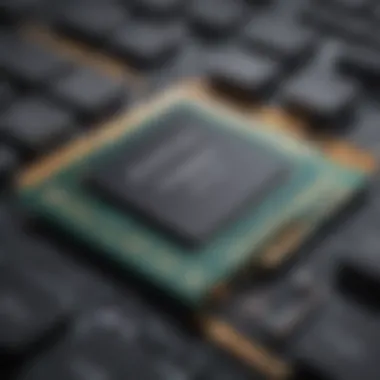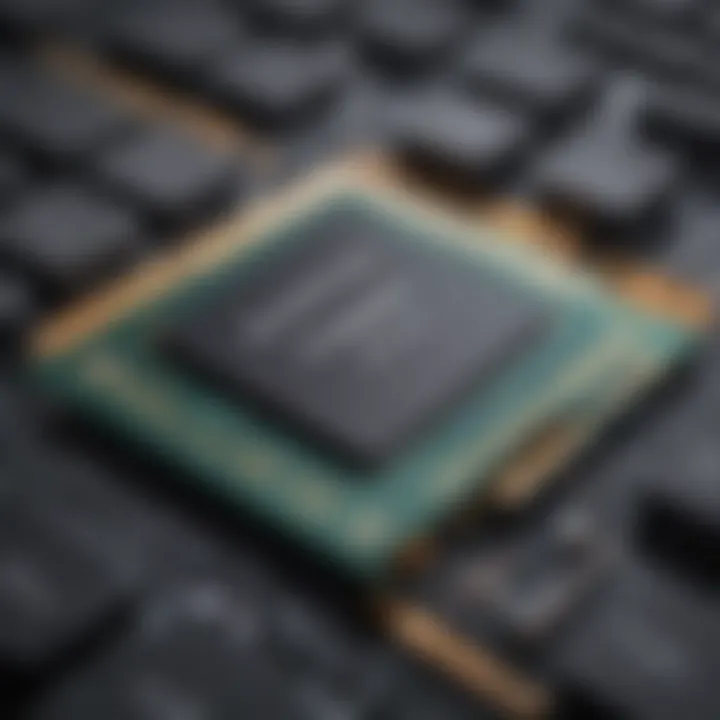The Quest for the Highest RAM: Performance and Efficiency


Product Overview
Preamble to Apple Products
Apple devices like MacBooks and iPads are among the leaders in technology, particularly known for their integrated hardware and software. These products are designed with a focus on performance and efficiency, making RAM an essential component of the computing experience. In this section, we will explore the key RAM configurations that enable these devices to function smoothly as well as analyze their impact on overall user experience.
Key Features and Specifications
RAM, or Random Access Memory, is vital for multitasking and running applications efficiently. Today, high-end models like the MacBook Pro and iPad Pro can be configured with up to 64GB of unified memory. This design means that RAM is utilized more efficiently between the CPU and GPU, leading to faster performance in demanding tasks such as video editing, gaming, and graphic design. The unique architecture helps simplify complex operations, which is especially beneficial for professionals who depend on processing power.
Design and Aesthetics
In addition to their robust performance, Apple products are known for their sleek designs. The MacBook and iPad feature a minimalist aesthetic, often incorporating aluminum casings and high-resolution Retina displays. The design is not just about appearance; it helps with thermal management, ensuring that the system remains cool even during intensive tasks. User experience is particularly enhanced by the attention to detail evident in the fine tuning of both hardware and software components.
Performance and User Experience
Performance Benchmarks
When evaluating performance, various benchmarks such as Geekbench and Cinebench highlight the impressive capabilities of Apple's A-series chips and M1 chip. These benchmarks demonstrate how higher RAM configurations lead to enhanced multitasking capacity, enabling users to open multiple applications without experiencing lags. This makes a significant difference for professionals who run resource-heavy software.
User Interface and Software Capabilities
The macOS and iPadOS have been engineered to effectively leverage available RAM. Processes such as memory management are handled gracefully allowing smooth transitions between applications and tasks. Users report satisfaction when moving between apps like Final Cut Pro and Adobe Photoshop due to the seamlessness offered by substantial RAM allocation.
User Experiences and Feedback
User feedback collected on forums like reddit.com indicates a general consensus about the importance of RAM. Many professionals in creative fields endorse configurations with 32GB or 64GB as necessary for optimal performance given their workflow requirements. The responsiveness of their devices remains a key point of discussion, particularly among those who require extensive processing in short timeframes.
Comparison with Previous Models or Competitors
Advancements and Improvements from Previous Models
Comparing newer MacBook and iPad Pro to their predecessors, significant improvements in RAM architecture can be observed. The introduction of support for increased RAM capacity transformed efficiency across both platforms. Previous models have slower memory speeds, which directly affect processing tasks that require bandwidth.
Competitive Analysis with Other Similar Products
Against competitors, Apple’s control over both hardware and software results in a highly specialized integration. Devices from Microsoft and Dell, although powerful, rely on their own operating systems which can lead to discrepancies in performance. Apple's use of optimized algorithms enables their devices to run more fluidly, even at comparable memory specs.
Value Proposition
The investment in higher RAM configurations is justified considering the performance returns. Many users appreciate the longevity of their device; they can often run current software efficiently even several years post-purchase, unlike models from some competitors which may feel sluggish as demands increase.
Tips and Tricks
How-to Guides and Tutorials for Optimizing Apple Product Performance
Obtaining the most from your device often requires minor adjustments:
- Reduce background processes: Assess applications running in the background. Only allow critical ones.
- Utilize Activity Monitor to analyze memory usage and close any demanding applications you aren’t using.
Hidden Features and Functionalities
Apple devices come equipped with numerous hidden tricks that many users may not recognize. For instance, the use of Split View for multitasking on iPads greatly enhances productivity.
Troubleshooting Common Issues
Common RAM-related headaches include memory leaks or applications consuming excessive RAM. Users should routinely restart their devices and clear out unused applications to maintain optimum performance levels. Simple wipes of cached files sometimes resolve these issues.
Latest Updates and News
Recent Developments in Software Updates and New Features
Apple continues to roll out software updates that enhance performance and usability. Recent releases introduced efficiency improvements that optimize RAM usage across platforms, making the transition smoother than in earlier versions.


Industry News and Rumors Surrounding Upcoming Products
Whispers around potential releases include uppgrades with even higher RAM capacities that are compatible with newer software advancements expected in the near future. Keeping an eye on resources like facebook.com can yield useful information for potential product announcements.
Events and Announcements from Apple
Apple events routinely spotlight significant innovations. Attending these reveals can prepare professionals for future developments in the industry, particularly concerning RAM technologies.
High RAM is not just an upgrade; it's a paradigm change in how devices perform, especially in demanding environments.
Prolusion
In today's ever-evolving technological landscape, understanding the role of RAM in computing is crucial. RAM, or Random Access Memory, serves as a essential component that greatly impacts performance efficiency in devices. Computers, laptops, and other devices rely on RAM to manage active tasks and applications, therefore, making it a determinant factor in speed, operations, and overall user experience.
One key element is that more RAM leads to better multitasking capabilities. Processes that demand quick access such as gaming, video editing, and programming require adequate memory allocation. Devices designed to run memory-intensive applications will benefit significantly from high-capacity RAM configurations.
The differences between RAM types and their corresponding speeds and efficiencies also highlight the importance of selecting the right specification. Factors like clock speed, bandwidth, and type affect how well a system utilizes memory.
Performance optimization is an essential consideration, too. Users can invest in faster RAM to complement existing hardware upgrades for an overall improved experience. As technology advances, knowing the appropriate RAM can help users clearly navigate software requirements and ensure facilities keep up with demands.
"In the quest for peak performance, the choice of RAM often determines the gap between an efficient machine and one laden with bottlenecks."
Moreover, with brands like Apple pushing the boundaries of technological innovation, it's essential to examine how their products such as MacBook Pro and iPad Pro utilize high RAM configurations to enhance usability further.
What is RAM?
Random Access Memory (RAM) serves a fundamental role in the functionality and efficiency of computing devices. In essence, it is the short-term memory of computers, where data is stored temporarily while applications are active. Proper airtiful of RAM allows for smoother user experiences across a wide variety of software applications unless revervation changes dictated by efficiency requirements. The following sections aim to key into the multiple aspects of RAM, showcasing what it does, why it matters, and the variances in type contributing to overall performance.
Definition and Purpose
RAM is a type of computer memory that allows data to be read and written quickly in real time. It is volatile, meaning that the input disappears when the device loses power or the program is closed. This characteristic distinguishes it significantly from long-term storage options like hard drives and SSDs. From running complex applications to simple tasks, RAM plays a critical role by holding the data readily available for the processor, greatly impacting the overall speed and functionality in any computing setup.
A clear understanding of how RAM operates can facilitate better decision-making regarding upgrades and configurations, ultimately aiding in improved performance and efficiency. Without adequate RAM, wearers could face sluggish operations, unresponsive applications, and poor multitasking capabilities that hamper effective user interaction.
Types of RAM
There are several types of RAM, each manifesting distinct characteristics that cater to specific advantages in performance and use cases. Understanding the various forms of RAM can guide choices during device selection or upgrades.
DRAM
Dynamic RAM, or DRAM, is arguably the most common type of RAM used in personal computers and many other devices. Its key characteristic is that it needs to be refreshed thousands of times per second, which can impact its overall speed or access time. Despite its need for refreshing, DRAM remains favored due to its low cost per bit, making it an economical choice for users looking to balance capacity and expense. This makes DRAM efficient for a wide range of applications from general office tasks to demanding computational workloads. However, the continual refreshing can also lead to higher latency compared to other RAM types.
SRAM
Static RAM, or SRAM, presents a conspicuously faster option compared to DRAM. SRAM retains data as long it has power, eliminating the need to refresh constantly. A benefit of SRAM is its speed, essential for caching or other high-performance requirements within computers and other devices. However, this speed comes with the downside of a higher cost and larger physical size compared to DRAM. Due to this, SRAM is typically utilized in limited capacities or particular tasks within computers, such as level 1 (L1) and level 2 (L2) cache memories, rather than main memory.
SDRAM
Synchronous Dynamic RAM (SDRAM) offers improvements over DRAM through synchronization with the system's clock speed, effectively increasing performance efficiency. SDRAM introduces pipeline architecture, allowing multiple column access during single row retrieval, thus speeding up processes significantly. When comparing SDRAM to older technologies, the benefits become evident particularly in high-performance systems where speed is essential. That being said, while it holds various blessings, it is often not as cost-effective as standard DRAM for tasks requiring vast amounts of memory, such as some workstation applications.
DDR Variants
Double Data Rate (DDR) variants further capitalize on the design of SDRAM. Superior in offering data transfer at double the clock rate while using the same circuit and power specifications, proper ramp-up of performance occurs. Different iterations include DDR2, DDR3, DDR4, and now DDR5. Each evolves capability, interdependency and, notable improvements in energy efficiency. Despite DDR technology ongoing facilitations providing heftier capacities within compact form factors, users are often tasked with navigating compatibility and performance concerns amidst rapidly changing architectures, somewhat flattening distinctive finales distinguishing each type.
Importance of RAM in Computing
RAM is a critical component in computing systems, affecting both the immediate performance and the overall efficiency of devices. As the bridge between the processor and storage, it influences how quickly devices can access data and execute tasks. Understanding RAM's capabilities can help optimize work flows and ensure users select iheir devices wisely.
RAM's Role in Performance
At its core, RAM serves as temporary storage, enabling an operating system and applications to retrieve data quickly. When you run multiple apps or work on resource-demanding software, if RAM is insufficient, it creates bottlenecks. The device slows down, leading to frustration for users engaged in demanding tasks like video editing or programming. With modern design practices prioritizing speed, devices, especially Apple's in the cutting-edge segment, equip high-capacity RAM to sustain fluid operations.
Many users may observe that systems equipped with ample RAM exhibit responsiveness in machine handling, better graphics rendering, and a faster boot time. Furthermore, performance stability is dependent on RAM speed and bandwidth as well.


- It is essential for many tasks to function without interruption.
- High RAM allows one to switch between tasks instantly.
Effects on Multitasking
Multitasking represents a significant aspect of modern computing, with many users often toggling between applications. Here, RAM's importance magnifies, as a higher memory capacity allows for handling Ferrari of tasks simultaneously. For example, a device with 16 GB or more of RAM can easily support web browsing, running development environments, and streaming high-definition videos—often at the same time.
Moreover, insufficient RAM leads to slowdowns or crashes in active workflows, markedly reducing productivity. Users might see an increase in application crashes if they have multiple applications open and insufficient RAM supporting them. Done right, RAM management elevates solving capabilities by providing enough working memory for applications.
Keep in mind that investing in devices with optimized RAM can enhance user expereance significantly, making complex calculations and data manipulations smoother.
Sufficient RAM capacity can effectively differentiate between seamless user experience and a sluggish, frustrating one. This is crucial for users demanding performance.
Maximum RAM Capacity in Current Devices
The capacity of RAM is a pivotal element in the world of computing. It determines how efficiently a device functions and can significantly affect overall performance. Current devices, particularly high-end models such as Apple products, have embraced increased RAM capacities, enabling users to experience better multitasking, accelerated processing speeds, and improved control over demanding applications.
Apple MacBook Pro Maximum RAM
Apple's MacBook Pro stands out by offering impressive RAM configurations. The latest models can accommodate up to 64GB of RAM, which is essential for professionals engaged in tasks like video editing, software development, or data analysis. With this capacity, users can run multiple complex applications simultaneously without noticeable lag. This ensures a smooth workflow, saving time and increasing productivity. It is important to understand why such capacities are beneficial. Larger RAM allocations enhance not just performance but also future-proofing of the device. Users investing in these models may find them still relevant years down the line, even as software demands increase.
iPad Pro RAM Specifications
The iPad Pro also offers significant RAM specifications that align with productivity needs. Recent iPad Pro models contain up to 16GB of RAM. This enhancement allows for seamless performance, particularly important when running multiple productivity apps or processing photos and videos. Apple designs these devices for versatility. Many professionals use the iPad Pro as a powerful alternative to laptops. A higher RAM capacity in tablets aids functionalities like drawing, editing, and conferencing applications, enabling users to take full advantage of its processing power.
Comparative Analysis with Competitors
In comparing Apple devices with their counterparts from other manufacturers such as Dell and ASUS, it is clear that while configurations may differ, the significance of RAM remains consistent across devices. Many competitors also equip their laptops and tablets with high RAM capacities; however, Apple's integration of hardware and software often leads to maximized performance. Other brands may slightly lag in optimized performance despite having similar RAM options. As a result, users must assess RAM capacity and how well it operates in conjunction with the device’s ecosystem. Thus, it becomes crucial to evaluate each option while considering unique use cases to determine what aligns best with personal computing needs.
Ultimately, maximum RAM capacity matters. It influences device performance and efficiency significantly. Consider your tasks and usage for optimal performance.
Advancements in RAM Technology
The field of Random Access Memory (RAM) has experienced rapid evolution in recent years. The upgrades in RAM technology not only aim to enhance performance but also increase efficiency in energy consumption. This holds great importance for consumer electronic devices, specifically for those working in high-demand environments like gaming, video editing, or software development. The latest advances showcase breakthroughs needed to sustain the growing processing requirements.
Trends in RAM Development
Several trends currently shape RAM development. First, there has been a significant push towards higher-speed RAM configurations. Innovations in Dual Data Rate (DDR) technology have consistently improved bandwidth per pin. This translates into enhanced multitasking qualities across devices. For example, DDR5 RAM offers improved speeds compared to its predecessor, DDR4, which can greatly impact overall system fluidity.
Another notable trend is the rising integration of RAM on processor chipsets. This shift has promoted reduced latencies and higher performance across devices. Consider Apple’s M1 silicon; its integration of RAM with the processor augments efficiency and system responsiveness, fuelling more powerful applications in devices like the MacBook Pro and the iPad Pro.
Moreover, developments are also focusing on power efficiency. New patterns in manufacturing and architecture result in RAM that not only performs well under heavy load but also consumes less power. This is especially relevant for mobile devices which should maximize battery life without sacrificing performance. Through innovations like Low Power Double Data Rate (LPDDR) RAM, manufacturers address these concerns, extending the longevity of devices even under heavy usage conditions.
- Enhanced data transfer speeds
- Increased energy efficiency
- Integration with CPUs for improved efficiency
“Future advancements in RAM will undoubtedly lead to a more streamlined user experience while ensuring energy efficiency continues to align with device performance.”
In summary, the trends in RAM development aim at blurring the lines between speed and efficiency, further becoming crucial for both consumer satisfaction and technological advancement.
Future of RAM in Computing
The future of RAM in computing looks promising. A rise in demanding applications from AI integration to high-resolution gaming will create a continuous need for powerful RAM solutions. Developers are already inching towards creating Non-Volatile RAM (NVRAM), which combines the advantages of traditional RAM with storage memory. This fusion can eliminate the latency issues prevalent in the distinction between storage and active memory, drastically enhancing access times.
Additionally, continuous miniaturization of components allows for larger RAM capacities within a specific physical size. This not only widens the user experience for high-performance computing but makes devices lighter and more wieldy.
Furthermore, with ongoing research into quantum computing, there is consideration of RAM technologies that operate based on entirely different principles. Understanding how traditional RAM can adapt in such advancing fields can open new doors for performance optimization in computing. Driven by new demands in several domains like cloud computing, artificial intelligence, and machine learning, the evolution is just beginning.
In closing, RAM advancements will be tightly interlinked with the ability of systems to handle future workloads efficiently. By recognizing and evolving with these trends, both users and developers can significantly leverage improvements in computing landscapes.
How to Choose the Right RAM for Your Device
Choosing the right RAM is a significant step for anyone looking to enhance their computing experience. Many factors can affect how well RAM performs in your device, impacting both efficiency and overall productivity. Understanding these factors helps users make informed decisions when upgrading or selecting hardware for their systems. Selecting RAM is not just about picking the model with the highest capacity; your requirements and budget must align to achieve the optimal setup.
Understanding Your Requirements


Every user's needs for RAM are unique, depending on various factors. What may be sufficient for one person could be inadequate for another. Here are key considerations:
- Usage Type: Identify the primary activities on your device. General web browsing and word processing may not require as much RAM as video editing or gaming. For more intensive applications, such as graphic design software or simulations, increasing RAM can provide a smoother experience.
- Operating System: Different operating systems have varying RAM requirements. For example, Ubuntu may consume significantly less RAM compared to Windows. Understanding your OS needs is essential to determine the right amount of RAM.
- Future-Proofing: If you plan to keep your device long-term or anticipate evolving needs, factor in situations where software updates or new applications might demand more memory. Opting for higher capacity can increase the longevity of your setup.
By evaluating these elements, one can discern the specific RAM configuration that aligns with personal demands without overspending.
Budget Considerations
Your budget plays an important role in selecting RAM. Tech enthusiasts may want the latest models, but it’s crucial to balance desire with financial reality. Here are some points to keep in mind:
- Performance vs. Cost: High capacity and speed RAM usually come at a premium. Ensure that the performance increase justifies the additional cost compared to alternatives that may meet your requirements at a lower price. For instance, if your device runs efficiently with 16GB, spending on 32GB may not be necessary.
- Warranty and Support: When upgrading or purchasing RAM, consider manufacturers' warranties and customer support. Often, brands like Crucial and Kingston provide extended warranties, indicating product quality and reliability.
- Local vs. Online Pricing: Prices can fluctuate based on sellers and local electronics markets. Doing research on platforms or checking sites like Amazon or Newegg can ensure you're getting a fair deal.
Detailed budgeting can help in selecting a configuration that meets performance goals without exceeding financial limits.
RAM selection is both an art and a science. Understand your current demands, always consider future usage, and be aware of the financial commitment involved.
Optimizing RAM Usage
Optimizing RAM usage is crucial for enhancing performance in modern computing devices. The efficiency of RAM in executing multiple processes determines how well a device functions, especially for those who engage in intensive tasks such as graphic design or software development. Efficient RAM usage prolongs device life, reduces unnecessary expenditure on upgrades, and improves the system’s overall responsiveness. Whether optimizing RAM in a MacBook Pro or an iPad Pro, there are strategic elements that guide users towards making informed decisions.
Best Practices
To effectively optimize RAM usage, users should consider the following practices:
- Close Unused Applications: Having many applications open can consume significant RAM. Regularly closing those not in active use can help enhance overall performance.
- Minimize Background Processes: Some applications run background processes that may not be visible but consume memory. It's wise to check what is running and disable those that are not required.
- Use Lighter Applications: When possible, opt for lightweight software alternatives. For example, using a simpler text editor instead of a full feature editor can save memory.
- Clear Cache Regularly: Temporary files can accrue over time. Cleaning the cache ensures the system runs more smoothly without unnecessary data taking up RAM.
- Upgrade RAM When Necessary: While interesting approaches can help, there comes a time when a hardware upgrade is the most effective solution.
Tools for RAM Management
Several tools exist that facilitate better RAM management and enhance user efficiency. Some noteworthy tools include:
- Activity Monitor (for Mac): This built-in utility helps users oversee what applications use the most RAM and enables the termination of unneeded tasks easily.
- CleanMyMac X: A holistic cleaning tool. It does not only clear garbage files but also optimizes RAM in real-time.
- Memory Cleaner: This application offers insight into active RAM. It provides options for freeing up memory with just a click.
- iStat Menus: A versatile tool for monitoring the overall performance, including RAM usage, with detailed statistics.
Common Myths about RAM
Understanding the common misconceptions surrounding RAM is a vital part of assessing its role in computing. A well-informed user invokes considerable advantages, particularly when selecting and optimizing RAM for personal devices. Myths can lead to misguided choices. Awareness of these myths helps clarify confusing elements and can grant enhanced efficiency where it was lacking.
Misconceptions Regarding Capacity
One of the frequent failings in understanding RAM lies in the comprehension of capacity. Many users think that simply having a high amount of RAM means improved performance. However, this is not always the case. For instance, a device with excessive RAM might not perform better than one with optimized levels of RAM for its tasks. Each system is designed with ideal RAM needs that coalesce with the processor and other hardware.
Memory-intensive applications such as large databases or extensive graphics editing tasks will benefit from increased capacity. Yet for typical daily computing needs like browsing or word processing, 8 to 16 GB of RAM is often ample. Thus, too much RAM can be wasted and lead users to overlook factors like speed and efficient usage of existing memory.
Computer enthusiasts may argue about the measures of memory, pushing for upgrades that exceed the utilization needs of their tools. This raises a pertinent inquiry: how much RAM is truly necessary? Calculating requirements effectively leads to wiser investments. Monitor application usage through tools to ascertain actual usage levels.
Performance Expectations
Another prevalent myth revolves around the assumption that more RAM equals better performance. This misconception fails to account for key variables that contribute to real-world performance. RAM alone does not dictate speed; the processor speed, SSD or HDD state, and system architecture play significant roles as well. A user who champions higher RAM volume may still face lags owing to an outdated CPU or sluggish storage system.
In practice, an excess in RAM won't alleviate all performance bottlenecks as expected. Understand that more isn't inherently better; rather, effectiveness is a composite of various hardware structures. Tasks like gaming or content production are fundamentally reliant on optimized hardware, and upgrading RAM could have further diminishing returns beyond specific points.
Applications will benefit from both speed and capacity when tuned into the specific demands of the use case. Specification mismatch leads to euphoria over vastly championed RAM configurations, with discontent quickly settling as usage lags behind the distribution of tasks.
Efficiency is about finding harmony among RAM capacity, processor speed, and overall system configuration. Troubleshoot and adapt setups as necessities evolve.
In summary, only choosing RAM based on raw capacity often leads users astray. Feel secure in individual computing needs, a mix of indispensable elements creates the actual performance gold. Realistic expectation levels and logical considerations make a marked difference in system alteration decisions.
Finale
In highlighting the criticality of RAM in modern technology, it is vital to reiterate its role as a performance enhancer. This article provided insights into various dimensions: from types of RAM to their capacities in devices like the Apple MacBook Pro and the iPad Pro. Understanding RAM’s role transcends mere specifications; it ventures into practical implications regarding user habits, software optimization, and future trends.
Highlighting fast DRAM and innovative features of DDR memory ensures users are aware of how these advancements align with their computing needs. Apple’s products are a prime focus, given their seamless user experience that benefits considerably from high-RAM configurations.
Moreover, practical recommendations that arise from our discussion emphasize the importance of informed decision-making. Users need to reflect on variables such as budget constraints, requirements for multitasking, and the nature of applications they utilize.
"Deciding on the right amount of RAM engages both understanding performance benefits and personal requirements."
With clearer context around optimizing RAM usage, consumers are equipped to better navigate the complexities of it. Here, the future lays apparent - with emerging technologies altering how devices benchmark performance metrics. Trends such as increased memory bandwidth and decreased power consumption signal a take of efficiency in processing tasks.
Ultimately, as technology continues to advance, the dialogue surrounding RAM provides essential insights into improving overall efficiency and efficacy within personal and professional domains. Thus, the quest for optimal RAM is not merely for data storage but fundamentally entwined with achieving superior technological performance. The insights we provided aim to engage a sophisticated audience, making them better equipped in their tech efficiency journey.



